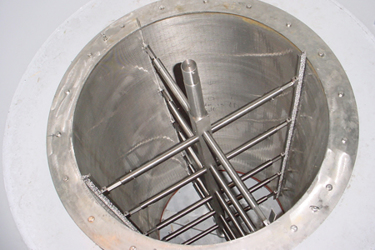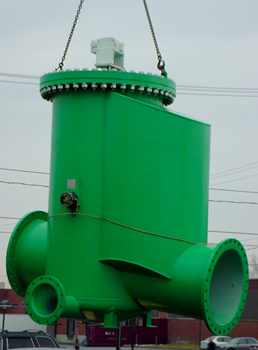Automatic Self-Cleaning Scraper Strainers Filter Smallest Particles To Largest Debris
By Robert Presser

Unlike backwash systems, scraper strainers reliably resist clogging and fouling when faced with micron-sized particles, oversized solids, and high solids concentration.
One key to providing reliable energy to the Kansas City area was using cooling water strainers that would not foul during the Missouri River’s high tide.
When a power plant was providing energy as a backup for a Kansas City power provider, the plant used river water for cooling, utilizing large basket strainers. The plant is now part of an energy solution partner with multiple district energy networks nationwide and sought more efficient operation and maintenance from a downtown steam loop that produced chilled water.
District energy uses a centrally located facility, or facilities, to generate thermal energy — heat, hot water, or chilled water — for a number of nearby buildings. These resources are transported through underground pipes to meet the needs of communities, cities, and campuses — such as colleges, hospitals, airports, and office parks.
“To provide condensing water for steam production as well as cooling water to the chillers and condensers, they take water from the Missouri River and put it through a once-through cooling system,” says Keith Williams, PE, who was involved with the project, and is a manufacturer's rep at Lenexa, KS-based Associated Equipment Sales, which represents North American manufacturers of heating, cooling, and hydronic equipment.
According to Williams, the river’s fast flow along with high tide complicated the straining of river water for the plant.
Williams notes that the power plant’s previous basket strainers required excessive maintenance. “They had to clean the manual strainers every shift, three times a day during high tide, and it was a very dirty, disgusting job that no one wanted to do,” he says.
Backwash strainers are often used but are not ideal for removing large solids from perforated screen elements. The backwash arm must be close to the screen to function properly, which prevents passing larger particles.
When solids are bigger than the gap between the screen and backwash arm, solids remain in the vessel and must be removed manually. Biological film can also adhere to the screen so frequent cleaning is usually required by maintenance crews.
In this case, a basket strainer was used, but was continuously clogged during the river’s high tide.
Williams was originally contacted as part of a plan to install new cooling towers. He instead advised that for this application, a more cost-effective solution was to install more efficient strainers.
“I advised using an automatic scraper strainer from Acme Engineering that is capable of very fine straining while still passing very large debris,” he says. “It can strain to the micron level yet can pass surprisingly large debris.”

Blowdown occurs only at the end of the intermittent scraping cycle when a valve is opened for a few seconds to remove solids from the collector area. Liquid loss is well below 1 percent of total flow.
According to Williams, the scraper basket also allows the strainer to bypass extremely large particles and debris. “There are very few manufacturers that can pass such large particles while straining out fine particles,” says Williams.
The automatic scraper strainer had to be customized to install on a 30” inlet and outlet with a 12” blowdown line for solids removal. Although industrial facilities with existing systems may be hesitant to replace under-performing backwash strainers due to the misperception that the installation modifications can be costly, some firms can custom manufacture pressure vessels to fit within the existing piping arrangement, which minimizes installation costs. They can even deliver units with backwash arms.
“The line they wanted to install it in was at a 15-degree angle in a very tight space with a very short line, so we made a strainer where the inlet and outlet angled at 15 degrees,” says Williams. “This enabled them to just cut the pipe, install the flanges and the strainer, and be done. It was a custom vessel.”
“The facility’s staff was impressed at how much the automatic scraper strainer simplified the maintenance of their strainer for cooling, despite the size range of river water debris it has to catch. Now, they only open it for annual inspection and maintenance, and no one has to manually clean it anymore,” he concludes.
Robert Presser is Vice President of Acme Engineering Prod., Inc., a North American manufacturer of industrial self-cleaning strainers. The company is an ISO 9001:2015 certified manufacturer of environmental controls and systems with integrated mechanical, electrical, and electronic capabilities. More info at acmeprod.com.
